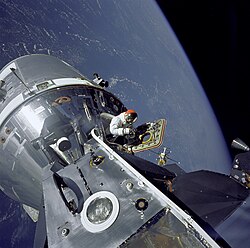Use in Apollo Program

The Block II Apollo command and service module carried a pair of elliptical VHF scimitar antennas on the Service Module walls. The antenna's scimitar shape wasn't externally visible, since it had to be covered by a shroud for aerodynamic purposes. The antenna radiated and received signals in an approximately hemispherical pattern, therefore two antennas were necessary to provide full omnidirectional coverage. [2] VHF communication was used for ship-to-ground communication in Earth orbit, and ship-to-ship communication with the Apollo Lunar Module. This was distinct from the unified S-band high-gain antenna used for communication with Earth at lunar distances.
The earlier Block I design of the Apollo spacecraft carried the scimitar antennas inside two semicircular strakes attached near the base of the Command Module, which were intended to improve aerodynamic stability during reentry. However, the strakes were found to be unnecessary, and would have been ineffective at high lunar return reentry speeds. Therefore, the strakes were deleted and the antennas were moved to the Service Module in the Block II design used in crewed missions.

The first two Lunar Modules to fly, Apollo 5 and Apollo 9, also carried a pair of VHF scimitar antennas for the transmission of Developmental Flight Instrumentation (DFI) telemetry data. [3] One was located on the front face, just inboard of the right-hand side cockpit window, and the other was located on the left side of the aft equipment bay. Since the Lunar Module never operated in the Earth's atmosphere, no aerodynamic covering was necessary, and the scimitar shape was externally visible. After Apollo 9, the Lunar Module was considered operational, so the DFI and scimitar antennas were not present on subsequent flights.
